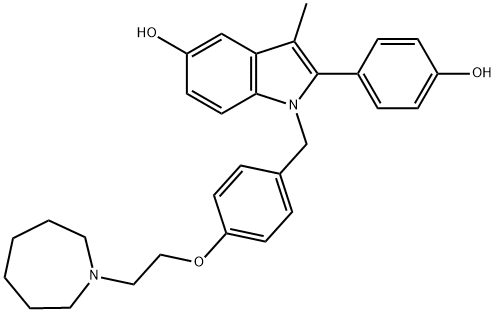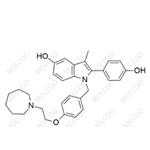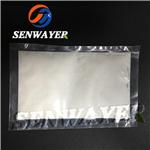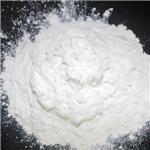Bazedoxifene is an nonsteroidal selective estrogen receptor modulator (SERM). Bazedoxifene is used as an antiosteoporotic.
ChEBI: Bazedoxifene is a phenylindole.
Bazedoxifene, 1-[[4-[2-(azepan-1-yl)ethoxy]phenyl]methyl]-2-(4-hydroxyphenyl)-3-methylindol-5-ol (Viviant), was declared to be “approvable” bythe FDA in 2007 for the prevention of postmenopausalosteoporosis. As of mid-2009, final approval in the UnitedStates is still pending. Bazedoxifene was approved inEurope in 2009 for the treatment of post–menopausalosteoporosis.
Bazedoxifene is an indole-based SERM that is under investigation for the treatment and prevention of
postmenopausal osteoporosis. It also is being evaluated in combination with Premarin (conjugated
estrogens). Bazedoxifene displaces 17β-estradiol from estrogen receptors and has excellent binding affinity for
the receptor itself. Unlike raloxifene, this agent does not cause hot flashes at the doses required to have a
beneficial effect on bone. In addition, it does not cause uterine or mammary gland stimulation.
This potent and selective estrogen receptor modulator, or SERM (FW =
530.65 g/mol; CAS 198481-33-3; Solubility: 00 mM in DMSO), also named
1-[[4-[2- (hexahydro-1H-azepin-1-yl) ethoxy]phenyl]methyl]-2- (4-
hydroxyphenyl) -3-methyl-1H-indol-5-ol, selectivity targets the extrogen
receptor ERα (IC50 = 26 nM), with weaker action against ERβ (IC50 = 99
nM), inhibiting 17β-estradiol-induced proliferation of MCF-7 cells.
Bazedoxifene represents a promising new treatment for osteoporosis, one
with a potential for less uterine and vasomotor effects than selective
estrogen receptor modulators now used clinically.



